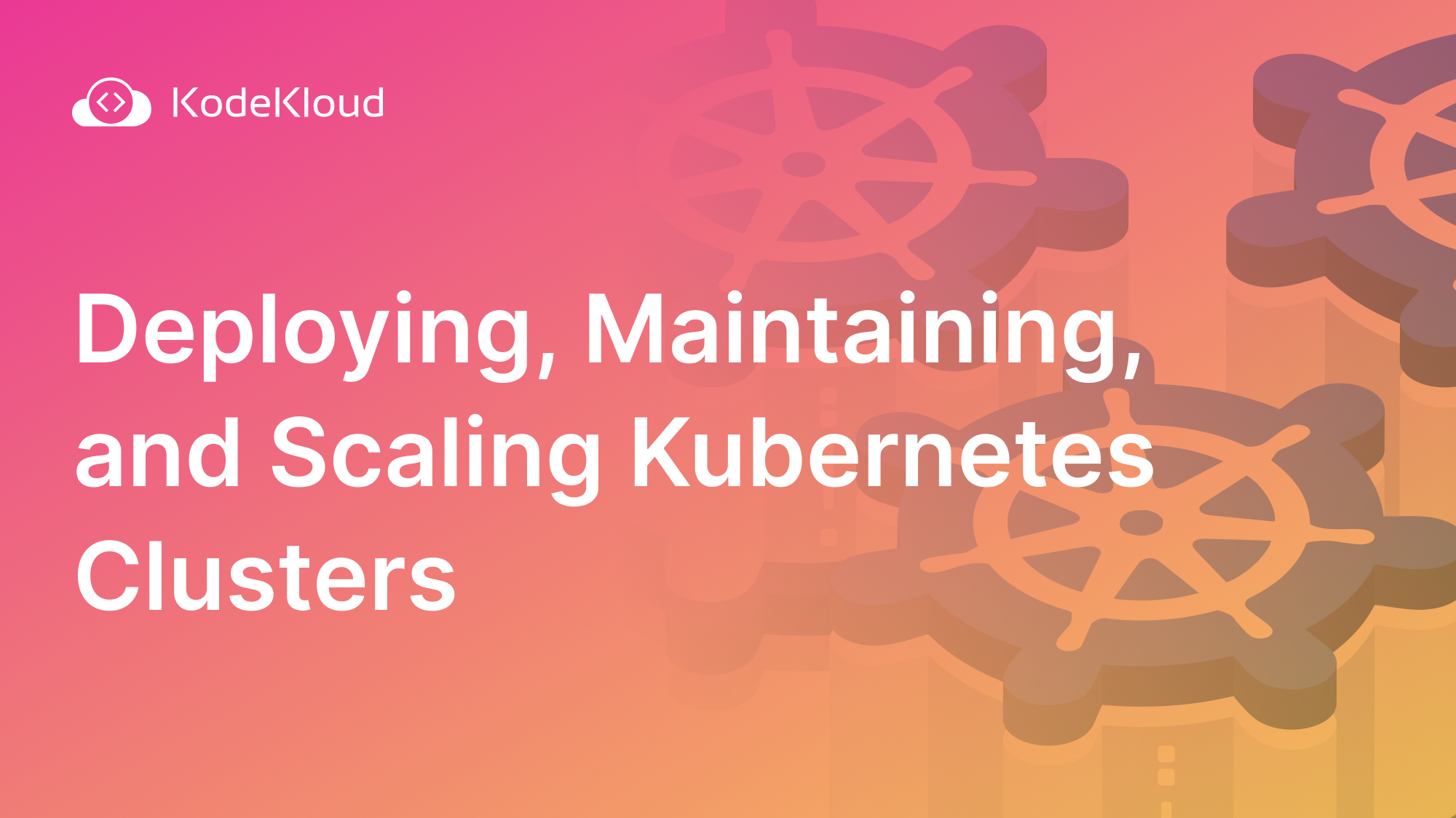How do you run containerized applications at scale with reliability and efficiency? If you are like most DevOps professionals, you probably use Kubernetes. It is the most popular and widely used container orchestration tool, with over 80% of the market share.
This article will help you understand the art and science of Kubernetes cluster management. We'll cover choosing the right deployment model, optimizing for high availability, implementing monitoring and logging, as well as scaling for complex workloads.
Choosing the Right Deployment Option - Managed vs. Self-Managed
An important decision that has to be made before deploying your workload is whether to use a managed or self-managed cluster. In this context, managed clusters are those offered by cloud service providers, and self-managed clusters are those set up using tools such as Kubeadmin. Below are some of the factors you should consider when making the decision:
- Requirements: What are your cluster’s functional and non-functional requirements? Consider factors such as performance, availability, scalability, security, and compliance.
- Resources: If you plan to use the managed service, consider the budget available. But if you plan to set up an on-premises cluster, consider the available hardware, software, and network.
- Skills: Consider the skills and expertise needed to set up, secure, and manage your cluster.
Here are some general guidelines that can help you make the decision:
- Managed Kubernetes Service – Saves time and effort if you don’t mind paying a premium price. Enables you to leverage the expertise and experience of the cloud provider and focus on adding value to your core business.
- Self-Managed Kubernetes Cluster – Provides you with more control and flexibility if you have the time and effort. Enables you to customize and optimize your Kubernetes clusters according to your specific requirements and preferences.
- Local Kubernetes Cluster – Quick and easy way to test, learn, or experiment. Allows you to test applications on a Kubernetes cluster without incurring the costs associated with a managed service or the complexity of self-managed clusters. Additionally, you’ll be able to experiment with different configurations and settings without worrying about affecting the live system.
Optimizing for High Availability
To achieve high availability for your Kubernetes clusters, you need to implement basic techniques like replication, health checks, and backup and restore. Beyond these, you can implement the following:
- Use Automatic Failover: Configure leader election in etcd to detect and recover from master node failures without downtime. This approach helps you avoid losing data or disrupting your cluster operation.
- Preserve Data Persistence: For stateful applications like PostgreSQL database, use dedicated PVCs or shared storage solutions like NFS/Ceph that Pod can mount on restart.
- Self-healing Cluster: Run DaemonSets that monitor your nodes and Pods and fix any issues before they affect your users. Set the CPU requests and limits for monitoring Pods to avoid throttling during usage spikes.
- Prepare for Disaster Recovery: Backup your etcd snapshots to an external database like Amazon S3 on a regular basis. Document your restore process and test it frequently to ensure that it works.
- Planned Maintenance: Use the Pod disruption budget to limit the impact of updates on your application. This way, you can gracefully take nodes out of service and avoid downtime or errors.
Not all these strategies are suitable for every workload. You need to test them in your non-production environments and choose the ones that meet your needs.
Implementing Monitoring and Logging
Raw metrics and logs mean nothing without effective visualization and alerting. Set up Prometheus, Elasticsearch, Grafana, and Loki effectively for good monitoring and logging, then follow these best practices:
- Combine all Clusters: Collect metrics/logs from all your Kubernetes environments and send them to a single Prometheus/Loki server for easy querying and alerting across your infrastructures.
- Scale up on Demand: Use HPA to adjust the compute resources of your observability stacks when they need to handle more load during incidents or maintenance.
- Isolate Different Tenants: Use namespaces to separate customer-specific data in your monitoring backend for better security and billing.
- Customize Dashboards: Create Grafana dashboards for different audiences, such as Developers, SREs, or executives, and show them the relevant signals for their roles. Integrate with ChatOps for faster communication.
- Fine-tune Performance: Adjust scrape intervals, retention policies, and shard counts to find the optimal trade-off between data freshness and storage usage based on your environment and SLOs
These techniques will streamline operational processes, catch bugs earlier, and demonstrate the value of Kubernetes to your stakeholders.
Scaling Kubernetes Cluster for Complex Workloads
Another important task in cluster management is implementing scaling to meet the changing demand and workload of your applications. For simple applications, scaling can easily be automated using a Vertical Pod Autoscaler (VPA) or a Horizontal Pod Autoscaler (HPA).
However, when working with complex workloads, scaling can often be challenging, especially when unpredictable or stateful behaviour is involved. In such cases, you can try these scaling techniques:
- Combine VPA and HPA: Use a VPA to adjust the resource requests and limits of your Pods before creating more replicas with HPA. This way, you can reduce resource wastage and improve the efficiency of your cluster
- Use Custom Metrics: To increase the accuracy of your. Feed HPA with custom metrics that reflect the actual usage patterns of your application, like queue depth, storage consumption, or request rate.
- Do Canary Testing: Fine-tune your scaling policies and avoid over-scaling or under-scaling your cluster by experimenting with different autoscaling settings, monitoring the errors and latency, and finding the best Pod capacity ranges for each workload.
- Enable Pod Preemption: Allow your high-priority workloads to evict the low-priority ones during peak demand and reclaim the resources immediately. This can help you ensure the performance and availability of your critical services and prevent queuing.
- Implement Cluster Autoscaler (CA): You can also let DaemonSet run a CA to automatically scale the number of your nodes based on the Pods' demand or resource availability. However, this may not always be able to scale up or down quickly enough to meet sudden changes in demand. This can lead to performance issues and unnecessary costs and resources being used. Use this technique when you don’t have frequent demand fluctuation.
Another feature that can help in optimal cluster scaling is using resource requests and limits.
Resource Requests and Limits
Kubernetes provides this feature to help you optimize your cluster for cost or performance. You can use resource requests and limits to specify the minimum and maximum amount of resources that each Pod or container needs. This can help Kubernetes schedule your Pods on the appropriate nodes and prevent them from consuming more resources than they should.
Want to master containerization? Enrol in our Kubernetes Learning Path:

Conclusion
In this article, we have covered some of the essential tasks for managing a Kubernetes cluster. We have discussed how to choose the right deployment option, optimize for high availability, implement monitoring and logging, and scale for complex workloads.
We hope that this article has been helpful and informative for you. If you have any questions or feedback, please feel free to leave a comment below.
More on Kubernetes:
- How to Collect Kubernetes Events and Extract Values
- How to Fix ImagePullBackOff & ErrImagePull in Kubernetes
- How to Use Kubectl Scale on Deployment
- How to Use Kubectl Config Set-Context
- How to Restart a Pod in Kubernetes
- How to Debug CrashLoopBackOff in a Container or Pod
- How to Get Pod Logs in Kubernetes (With Examples)
- How to Copy File From Pod to Local (With Examples)




















Discussion